Short answer: Cut off the root and dark green parts of the leek. Slice it lengthwise in half, then cut each half into thin half-moon shapes.
Leeks, a member of the onion family, are a wonderful ingredient to add flavor to a wide variety of dishes. Despite their usefulness in cooking, they can be a bit tricky to cut due to their unique structure. However, with the right technique, slicing leeks can be quick and simple. This process involves trimming off the root and dark green ends, slicing the leek in half lengthwise, and then cutting into thin half-moon shapes.
How To Slice Leeks?
Method 1: For Sliced Leeks And Half-Moons:
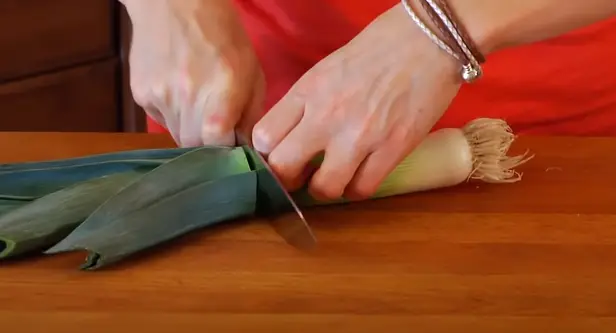
Step 1: Cut off the top dark green part of the leek. These are tough and fibrous, so they’re not ideal for eating, but they’re great for flavoring in vegetable stock.
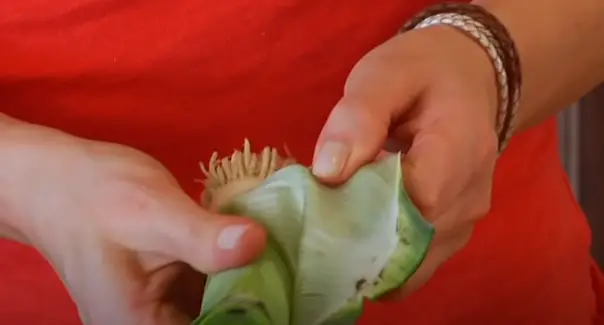
Step 2: Examine the outer leaves and remove any that look tough and fibrous.
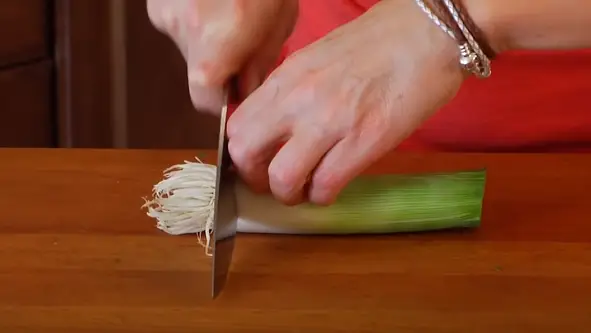
Step 3: Cut off the base of the leek, where you see the small roots.
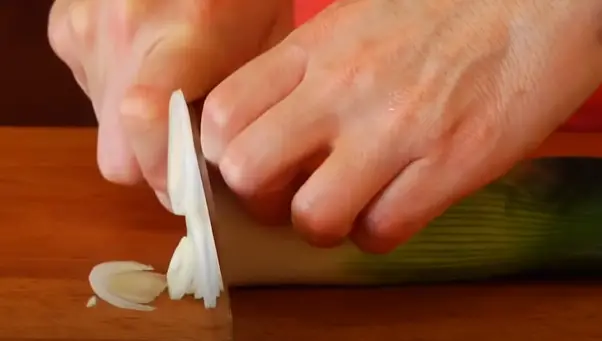
Step 4: If you need sliced leeks, continue slicing up the leek as thinly or thickly as you need. If you need leeks cut into half-moons, slice the leek lengthwise down the center, then lay it flat side down and continue slicing.
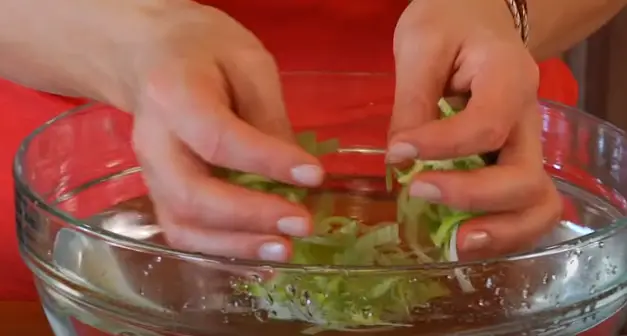
Step 5: To clean the leeks, place them in a large bowl of cold water and swish them around. The dirt and grit will fall to the bottom of the bowl.
Step 6: Scoop the clean leeks from the top and transfer them to a colander. Be sure not to pour the dirty water over the leeks.
For Whole Leeks:
Step 1: Trim off the dark green tops and the roots at the base. Ensure it’s a thin slice to keep the leek intact.
Step 2: Remove any tough outer leaves.
Step 3: Slice the leek in half lengthwise, but start about an inch from the base to keep it intact.
Step 4: The inside of the leek will be quite dirty. The parts towards the middle are light green, white, and tender, while the dark green parts at the top can be removed.
Step 5: Clean the leek by holding it upside down under cold running water. This allows you to rinse each layer and let the dirt and grit wash into the sink. Make sure the leek is upside down, so the dirt doesn’t run into it.
Method 2:
Identify the parts of the leek: the dark green top, the white middle, and the root at the bottom.
<
Step 1: Cut off the dark green part and set it aside for stocks or soups.
Step 2: To clean the leek, first, make a lengthwise cut along the leek, then turn it a half or quarter turn and make another lengthwise cut.
Step 3: Rinse the leek under running water to clean out any excess dirt that may be stuck in between the layers.
Step 4: After cleaning, chop the leek using a rocking motion with your knife. Be sure to keep your fingers tucked away for safety, allowing only your knuckles to guide the knife.
Step 5: Continue chopping down to the root. The white part is especially good, so be sure to use as much of it as possible.
Method 3:
Step 1: Begin by cutting off the end of the leek where the small roots are located.
Step 2: Pull off any outer leaves that look wilted or discolored.
Step 3: Cut off about two-thirds of the top green part. While it can be used in some recipes, it’s not always necessary.
Step 4: Cut the remaining leek into three equal parts lengthwise.
Step 5: Cut down the middle of each section to create thin strips, also known as julienne. However, this step is optional based on your preference.
Step 6: Place the cut leeks in a colander and thoroughly rinse them under running water to remove any grit.
Step 7: Once rinsed and drained, the leeks are ready to be cooked.
Method 4:
Step 1: Cut off the heavy root stalk at the end of the leek.
Step 2: Cut off the dark green portion of the leek. This part is typically inedible.
Step 3: Cut the remaining part of the leek in half lengthwise.
Step 4: Rinse the leek halves under running water to remove any sand or dirt. Leeks are often grown in sandy soil, so they tend to have sand trapped in their layers.
Step 5: Using your fingers in a claw-like shape and your knuckle as a guide, slice the leeks to about an eighth of an inch thick.
Method 5: Preparing Leeks For Soup
Step 1: Start by cutting off the very end of the root of the leek.
Step 2: Cut off about 3 inches from the leafy end, leaving a small part of the leaf on the top.
Step 3: Peel off the outer layer of the leaf, revealing the inner part of the leek.
Step 4: Slice the leek in half lengthwise, right down the middle.
Step 5: Slice each half again in the same direction. This will allow you to thoroughly wash the inside of the leek, where dirt tends to build up.
Step 6: Rinse the leeks well under running water, ensuring no dirt remains, especially on the outermost parts.
Step 7: Thinly slice the rinsed leeks.
How To Use Leeks?
Soups: Leeks can be added to soups for a mild, sweet, and slightly onion-like flavor. They can be sautéed with other aromatics like onions and garlic before adding the main ingredients.
Stews: Sliced leeks can be incorporated into stews for added texture and a subtle sweet flavor. They pair well with meats, beans, and other vegetables.
Risottos: Leeks can be used in risottos to contribute to the dish’s overall creamy texture and to provide a mild onion-like taste without overpowering other flavors.
Quiches: Leeks are a great addition to quiches. They can be lightly sautéed before being mixed with the egg and cream mixture, adding a sweet and slightly earthy flavor.
Stir Fry: In stir-fry dishes, leeks can be used along with other vegetables and proteins. They provide a distinct flavor and can be cooked quickly at high heat.
Frittatas: Similar to quiches, sliced leeks can be added to frittatas for extra flavor and texture.
Stuffing: Leeks can be used as part of the vegetable mixture in stuffing recipes for poultry or vegetables, offering a unique, sweet twist to the flavor profile.
Pizza Topping: Sliced and lightly sautéed leeks can be used as a pizza topping, giving a sweet, onion-like flavor that complements other toppings well.
Fried Rice: In fried rice dishes, leeks can replace or complement other alliums like onions or scallions, contributing a unique flavor.
FAQs
Can you eat leeks raw?
Yes, you can eat leeks raw, although they might have a strong flavor. It’s recommended to slice them thinly or chop them finely if you plan to eat them raw in salads or salsas.
Can you boil leeks?
Yes, you can boil leeks. Boiling is a common cooking method for leeks and it helps to soften their texture and milden their flavor. You usually need to boil them for about 15-20 minutes until they are tender.
Are cooked leeks healthy?
Yes, cooked leeks are healthy. They are a good source of vitamins A, C, and K, and provide important minerals like manganese and iron. Cooking can make them easier to digest and their nutrients more readily available.
How much is one leek chopped?
One medium-sized leek usually yields about 1 cup of chopped leeks. However, this might vary depending on the size of the leek and how finely it’s chopped.
Can I freeze sliced leeks?
Yes, you can freeze sliced leeks. It’s best to blanch them quickly in boiling water before freezing to preserve their color and flavor. Make sure to dry them thoroughly and freeze them in a single layer before transferring to a freezer bag or container.
Can you eat the green part of the leek?
The dark green part of the leek is tougher and has a stronger flavor than the white and light green parts. While it’s not typically eaten in most recipes, it can be used in making stocks or broths. If you do choose to eat it, it’s best to cook it for longer to soften its tough texture.
Conclusion
Leeks are versatile vegetable that offers a unique and mild flavor to a variety of dishes. Their preparation involves careful cleaning and slicing, given their growth in sandy soil that may leave grit inside their layers. Whether you’re cooking them whole, slicing them into rounds, or half-moons, the culinary applications of leeks are vast, ranging from soups, stews, and risottos to quiches, stir fry and pizza toppings. They’re not only tasty but also packed with essential nutrients, contributing to a healthy diet. And with the right preparation, even their typically discarded parts, such as the dark green leaves, can be utilized in making flavorful broths or stocks, ensuring nothing goes to waste.

John Hebdon is a food enthusiast, passionate chef, and author of various articles and blog posts related to food and cooking. With a deep love for all things culinary, John’s blog serves as a platform to share his extensive kitchen experiences with a broader audience.
In addition to his culinary expertise, John has a flair for writing and a natural ability to share his passion for food with others. His articles and blog posts are informative, engaging, and packed with practical tips for readers of all skill levels.
As a food enthusiast and writer, John is always on the lookout for new and exciting culinary experiences. Whether it’s trying out a new restaurant, experimenting with a new recipe, or simply sharing a favorite dish with friends and family, John is always eager to explore and share the world of food with others.






